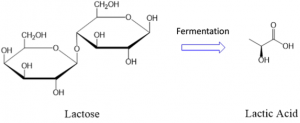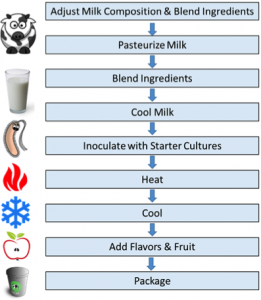By Christina Marvin
Yogurt is a yummy treat, but did you know that one of the main ingredients is live bacteria?
Is it dangerous to eat bacteria?

Don’t worry, yogurt contains only good kinds of bacteria, not the ones that make you sick. In fact, many bacterial species used in yogurt actually help your digestive system work properly.
Your gut contains several kinds of bacteria, including healthy varieties that aid digestion. Many yogurts have special bacteria called probiotics. Probiotics in yogurt repopulate the good bacteria in your stomach and intestines and help keep your digestive system in good health.
Why are there bacteria in yogurt?
The two most common yogurt cultures are Streptococcus thermophilus and Lactobacillus bulgaricus. By law, all yogurt must include these two strains. Companies often add additional probiotic cultures such as Lactobacillus acidophilus, Lactobacillus casei, and Bifido-bacteria. Yogurt is made when these specific bacteria are added to milk. They turn the milk into yogurt through fermentation, a process by which microorganisms such as bacteria convert sugars into alcohols or acids.

People who are lactose intolerant have a hard time digesting milk products due to the presence of a complex sugar, lactose. Unlike many people, yogurt bacteria find lactose delicious. When mixed with milk, bacteria quickly gobble up lactose and, through fermentation, convert it into lactic acid. Most people who are lactose intolerant find it easier to eat yogurt compared with other dairy products because the bacteria digest some of the lactose for them. Increase in acid lowers milk pH, causing liquid milk to clot and turning it into semisolid yogurt. Acid is also responsible for yogurt’s tart taste.
How do companies make yogurt?

Yogurt bacteria are thermophilic, which means that they love hot environments. In fact, they only begin fermentation when mixed with milk at very high temperatures (between 86 and 114 °F). Companies can make large quantities of yogurt in as little time as 2-12 hours. They start with the type of milk that will produce yogurt with the desired fat content. Different types of milk are needed to make yogurt with different fat contents: whole milk for full fat yogurt, low fat milk for lowfat yogurt, and skim milk for nonfat yogurt.
Companies first process the milk which includes adding solids and stabilizers that improve texture and increase firmness, pasteurizing the milk, blending the ingredients and, finally, cooling the mixture. Then, companies mix the milk with the bacteria, heat the new mixture, and let it cool. Within 2-12 hours, milk fermentation thickens the mixture and the yogurt is ready to be processed and packaged.
Still don’t believe it? Under the main ingredients, yogurt containers almost always add: “Contains live and active cultures” – check it out the next time you sit down to enjoy a delicious yogurt cup!
Edited by Kelsey Gray and Sam Stadmiller

